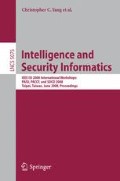Abstract
Developing effective suspicious activity detection methods has become an increasingly critical problem for governments and financial institutions in their efforts to fight money laundering. Previous anti-money laundering (AML) systems were mostly rule-based systems which suffered from low efficiency and could can be easily learned and evaded by money launders. Recently researchers have begun to use machine learning methods to solve the suspicious activity detection problem. However nearly all these methods focus on detecting suspicious activities on accounts or individual level. In this paper we propose a sequence matching based algorithm to identify suspicious sequences in transactions. Our method aims to pick out suspicious transaction sequences using two kinds of information as reference sequences: 1) individual account’s transaction history and 2) transaction information from other accounts in a peer group. By introducing the reference sequences, we can combat those who want to evade regulations by simply learning and adapting reporting criteria, and easily detect suspicious patterns. The initial results show that our approach is highly accurate.
Access this chapter
Tax calculation will be finalised at checkout
Purchases are for personal use only
Preview
Unable to display preview. Download preview PDF.
References
U.S. Congress, Information technologies for the control of money laundering. Office of Technology Assessment, Report OTA-ITC-630, U.S. Government Printing Office, Washington, DC (1995)
Liu, X., Zhang, P.: Research on Constraints in Anti-Money Laundering (AML) Business Process in China Based on Theory of Constraints. In: Hawaii International Conference on System Sciences, Proceedings of the 41st Annual, p. 213 (2008)
Force, F.A.T.: Report on Money Laundering Typologies, 2000-2001 (2002) English ed. Accessed
Senator, T.E.: Ongoing management and application of discovered knowledge in a large regulatory organization: a case study of the use and impact of NASD Regulation’s Advanced Detection System (RADS). In: Proceedings of the sixth ACM SIGKDD international conference on Knowledge discovery and data mining, pp. 44–53 (2000)
Goldberg, H., Senator, T.E.: Restructuring databases for knowledge discovery by consolidation and link formation. In: Proceedings of 1998 AAAI Fall Symposium on Artificial Intelligence and Link Analysis (1998)
Senator, T.E., et al.: The financial crimes enforcement network AI system(FAIS): identifying potential money laundering from reports of large cash transactions. The AI magazine 16(4), 21–39 (1995)
Tang, J., Yin, J.: Developing an Intelligent Data Discriminating System of Anti-Money Laundering Based on SVM. In: Proceedings of 2005 International Conference on Machine Learning and Cybernetics, 2005 (2005)
Wang, S.N., Yang, J.G.: A Money Laundering Risk Evaluation Method Based on Decision Tree. In: International Conference on Machine Learning and Cybernetics, 2007 (2007)
Zhu, T.: Suspicious Financial Transaction Detection Based on Empirical Mode Decomposition Method. In: IEEE Asia-Pacific Conference on Services Computing, 2006. APSCC 2006, pp. 300–304 (2006)
Zhu, T.: An Outlier Detection Model Based on Cross Datasets Comparison for Financial Surveillance. In: IEEE Asia-Pacific Conference on Services Computing, 2006. APSCC 2006, pp. 601–604 (2006)
Sankoff, D., Blanchette, M.: Multiple Genome Rearrangement and Breakpoint Phylogeny. Journal of Computational Biology 5(3), 555–570 (1998)
Gombay, E.: Sequential change-point detection with likelihood ratios. Statistics and Probability Letters 49(2), 195–204 (2000)
Gavrilov, M., et al.: Mining the stock market: Which measure is best. In: Proc. of the 6th ACM SIGKDD (2000)
Lane, T., Brodley, C.E.: Temporal sequence learning and data reduction for anomaly detection. ACM Transactions on Information and System Security (TISSEC) 2(3), 295–331 (1999)
Rafiei, D., Mendelzon, A.: Similarity-based queries for time series data. In: Proceedings of the 1997 ACM SIGMOD international conference on Management of data, pp. 13–25 (1997)
Banerjee, A., Ghosh, J.: Clickstream clustering using weighted longest common subsequences. In: Proc. of the Workshop on Web Mining, SIAM Conference on Data Mining, p. 33 (2001)
Antunes, C.M., Oliveira, A.L.: Temporal data mining: An overview. In: KDD Workshop on Temporal Data Mining, pp. 1–3 (2001)
Agrawal, R., et al.: Fast Similarity Search in the Presence of Noise, Scaling, and Translation in Time-Series Databases. In: Proceedings of the 21th International Conference on Very Large Data Bases, pp. 490–501 (1995)
Author information
Authors and Affiliations
Editor information
Editors and Affiliations
Rights and permissions
Copyright information
© 2008 Springer-Verlag Berlin Heidelberg
About this paper
Cite this paper
Liu, X., Zhang, P., Zeng, D. (2008). Sequence Matching for Suspicious Activity Detection in Anti-Money Laundering. In: Yang, C.C., et al. Intelligence and Security Informatics. ISI 2008. Lecture Notes in Computer Science, vol 5075. Springer, Berlin, Heidelberg. https://doi.org/10.1007/978-3-540-69304-8_6
Download citation
DOI: https://doi.org/10.1007/978-3-540-69304-8_6
Publisher Name: Springer, Berlin, Heidelberg
Print ISBN: 978-3-540-69136-5
Online ISBN: 978-3-540-69304-8
eBook Packages: Computer ScienceComputer Science (R0)

